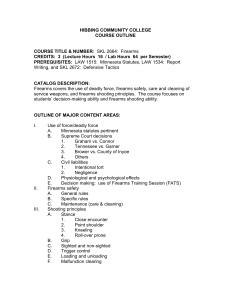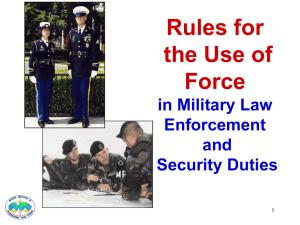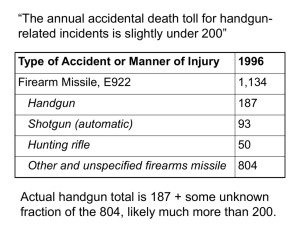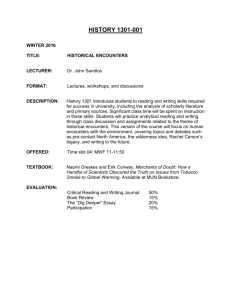IV. To Delete or Change an Existing Course
advertisement
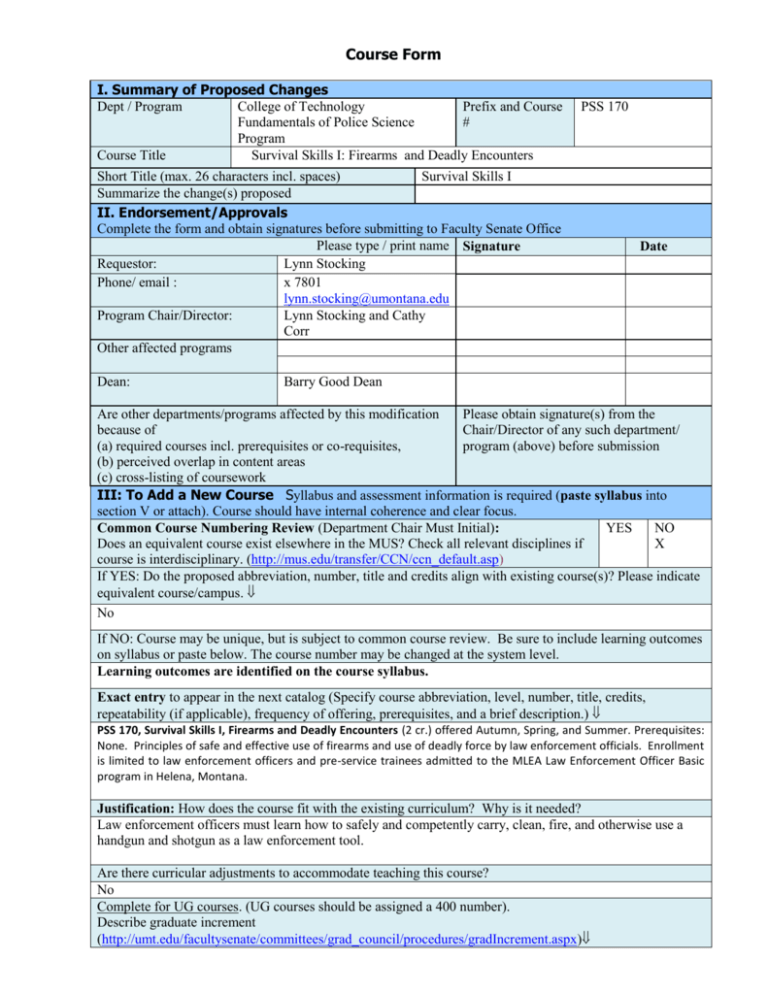
Course Form I. Summary of Proposed Changes Dept / Program College of Technology Prefix and Course Fundamentals of Police Science # Program Course Title Survival Skills I: Firearms and Deadly Encounters PSS 170 Short Title (max. 26 characters incl. spaces) Survival Skills I Summarize the change(s) proposed II. Endorsement/Approvals Complete the form and obtain signatures before submitting to Faculty Senate Office Please type / print name Signature Requestor: Lynn Stocking Phone/ email : x 7801 lynn.stocking@umontana.edu Program Chair/Director: Lynn Stocking and Cathy Corr Other affected programs Dean: Date Barry Good Dean Are other departments/programs affected by this modification Please obtain signature(s) from the because of Chair/Director of any such department/ (a) required courses incl. prerequisites or co-requisites, program (above) before submission (b) perceived overlap in content areas (c) cross-listing of coursework III: To Add a New Course Syllabus and assessment information is required (paste syllabus into section V or attach). Course should have internal coherence and clear focus. Common Course Numbering Review (Department Chair Must Initial): YES NO Does an equivalent course exist elsewhere in the MUS? Check all relevant disciplines if X course is interdisciplinary. (http://mus.edu/transfer/CCN/ccn_default.asp) If YES: Do the proposed abbreviation, number, title and credits align with existing course(s)? Please indicate equivalent course/campus. No If NO: Course may be unique, but is subject to common course review. Be sure to include learning outcomes on syllabus or paste below. The course number may be changed at the system level. Learning outcomes are identified on the course syllabus. Exact entry to appear in the next catalog (Specify course abbreviation, level, number, title, credits, repeatability (if applicable), frequency of offering, prerequisites, and a brief description.) PSS 170, Survival Skills I, Firearms and Deadly Encounters (2 cr.) offered Autumn, Spring, and Summer. Prerequisites: None. Principles of safe and effective use of firearms and use of deadly force by law enforcement officials. Enrollment is limited to law enforcement officers and pre-service trainees admitted to the MLEA Law Enforcement Officer Basic program in Helena, Montana. Justification: How does the course fit with the existing curriculum? Why is it needed? Law enforcement officers must learn how to safely and competently carry, clean, fire, and otherwise use a handgun and shotgun as a law enforcement tool. Are there curricular adjustments to accommodate teaching this course? No Complete for UG courses. (UG courses should be assigned a 400 number). Describe graduate increment (http://umt.edu/facultysenate/committees/grad_council/procedures/gradIncrement.aspx) New fees and changes to existing fees are only approved once each biennium by the Board of Regents. The coordination of fee submission is administered by Administration and Finance. Fees may be requested only for courses meeting specific conditions according to Policy 940.12.1 http://mus.edu/borpol/bor900/940-12-1.pdf . Please indicate whether this course will be considered for a fee. If YES, what is the proposed amount of the fee? Justification: IV. To Delete or Change an Existing Course – check X all that apply Deletion Title Course Number Change From: Level U, UG, G To: Description Change Change in Credits From: To: Prerequisites 1. Current course information at it appears in catalog (http://www.umt.edu/catalog) YES NO X From: To: Repeatability Cross Listing (primary program initiates form) Is there a fee associated with the course? 2. Full and exact entry (as proposed) 3. If cross-listed course: secondary program & course number 4. Is this a course with MUS Common Course Numbering? http://mus.edu/transfer/CCN/ccn_default.asp If yes, please explain below whether this change will eliminate the course’s common course status. YES NO 5. Graduate increment if level of course is changed to UG. Have you reviewed the graduate Reference guidelines at: increment guidelines? Please check (X) space provided. http://umt.edu/facultysenate/committees /grad_council/procedures/gradIncrement.aspx (syllabus required in section V) 6. Other programs affected by the change 7. Justification for proposed change V. Syllabus/Assessment Information Required for new courses and course change from U to UG. Paste syllabus in field below or attach and send digital copy with form. THE UNIVERSITY of MONTANA COLLEGE of TECHNOLOGY AA—Fundamentals of Police Science Concentration Course Syllabus COURSE NUMBER AND TITLE: PSS 170 Survival Skills I: Firearms and Deadly Encounters DATE: Autumn 2012 SEMESTER CREDITS: 2 PREREQUISITES: None FACULTY: MLEA Faculty E-Mail: Phone: Office: Office Hours: COURSE DESCRIPTION: PSS 170 Survival Skills I, Firearms and Deadly Encounters (2 cr.) offered Autumn, Spring, and Summer. Prerequisites: None. Principles of safe and effective use of firearms and use of deadly force by law enforcement officials. Enrollment is limited to law enforcement officers and pre-service trainees admitted to the MLEA Law Enforcement Officer Basic program in Helena, Montana. STUDENT PERFORMANCE OUTCOMES: Performance Objectives Upon completion of this course, the student will: Part I: Firearms 1. Demonstrate a proper shooting stance. 2. Demonstrate the skills and tactics needed for a proper weapons draw. 3. Demonstrate correctly holstering the duty handgun using the four-point system. 4. Correctly reload a semi-automatic pistol or revolver with both hands and with only one hand. 5. Correctly clear a semi-automatic pistol or revolver malfunction. 6. Demonstrate the skills and tactics to apply a proper grip of the handgun, and proper trigger control and manipulation. 7. Apply a proper sight alignment and sight picture. 8. Describe and demonstrate the cardinal rules of firearms safety. 9. Demonstrate the 90 and 180 degree pivot drills with a handgun and shotgun. 10. Demonstrate the skills and tactics to use correctly cover while firing a duty handgun. 11. Demonstrate how to fire correctly a handgun with the strong and with the weak hand. 12. Demonstrate the skills and tactics needed to load correctly/tactically a shotgun while under stress; and also correctly combat load a shotgun while under stress. 13. Demonstrate skills and tactics to clean correctly a handgun and a shotgun. 14. Demonstrate the following: static position components; lateral, forward, rearward, diagonal and off the box movements; close quarters combat and night shooting techniques. 15. Perform the snake drill, shooting techniques in a stress course, and shooting techniques in a tactical scenario. 16. Perform shotgun shooting techniques including standing, kneeling, prone, slug and 00 buck shot. 17. Demonstrate high, low and kneeling drills when transitioning from the police long gun to the handgun in the event of a malfunction or empty long gun. Part II: Deadly Encounters 1. Identify potential deadly encounters. 2. Demonstrate practical tactics in applying deadly force. 3. Demonstrate proficiency using weapons including duty handguns and shotguns. 4. Discuss factors to be considered when making decisions about use of force and when to apply deadly force. STUDENT PERFORMANCE ASSESSMENT METHODS AND GRADING PROCEDURES: (Production and Testing) Various final call/performance assessment scenarios. Successfully perform and pass the MLEA Law Enforcement Officer Basic Course Qualification Course (requiring approximately 38 hours). GRADING SCALE: Students must earn a minimum score of 75% or letter grade of “C” in this course to receive both program and course credit. 94 – 100 84 – 93 A B Excellent Good 75 – 83 70 – 74 69/below C D F Satisfactory Poor Failure ATTENDANCE POLICY: Students are required to come prepared for class each day and participate in the assigned activities. In-class activities account for a substantial portion of the final grade. ACADEMIC INTEGRITY: All students must practice academic honesty. Academic misconduct is subject to an academic penalty by the course instructor and/or a disciplinary sanction by the University. All students need to be familiar with the Student Conduct Code. The Code is available for review online at http://life.umt.edu/vpsa/student_conduct.php. DISABILITY ACCOMMODATION: Eligible students with disabilities will receive appropriate accommodations in this course when requested in a timely way. Please contact me after class or in my office. Please be prepared to provide a letter from your DSS Coordinator. For more information, visit the Disability Services website at http://www.umt.edu/dss or call 406.243.2243 (Voice/Text). REQUIRED TEXTBOOKS: Montana Law Enforcement Academy. (2009). ‘Law Enforcement Officer Basic Course Study Guide. Montana Law Enforcement Academy’, (V5.0). Helena, Montana. COURSE OUTLINE: Part I: Firearms 1. Shooting stance, weapons draw and proper holstering techniques 2. Semi-automatic pistol or revolver reloading with both or only one hand 3. Correcting handgun firing malfunctions 4. Proper handgun grip, trigger control and manipulation 5. Sight alignment and picture 6. Firearm safety 7. Practice handgun and shotgun pivot drills 8. Use of cover while firing a duty handgun 9. Handgun shooting using strong hand and weak hand 10. Loading and combat loading a shotgun under stress 11. Law Enforcement Qualification Course 12. Various shooting techniques, e.g., lateral, forward, rearward, close quarters, night 13. Snake drill; stress course and tactical scenario shooting techniques 14. Shotgun performance techniques including standing, kneeling, prone, etc 15. Malfunction events requiring transitions from long gun to handgun Part II: Deadly Encounters 1. Tactics in applying force in deadly encounters 2. Weapons skills 3. Decision making regarding use of deadly force VI Department Summary (Required if several forms are submitted) In a separate document list course number, title, and proposed change for all proposals. VII Copies and Electronic Submission. After approval, submit original, one copy, summary of proposals and electronic file to the Faculty Senate Office, UH 221, camie.foos@mso.umt.edu. Revised 9-2010
